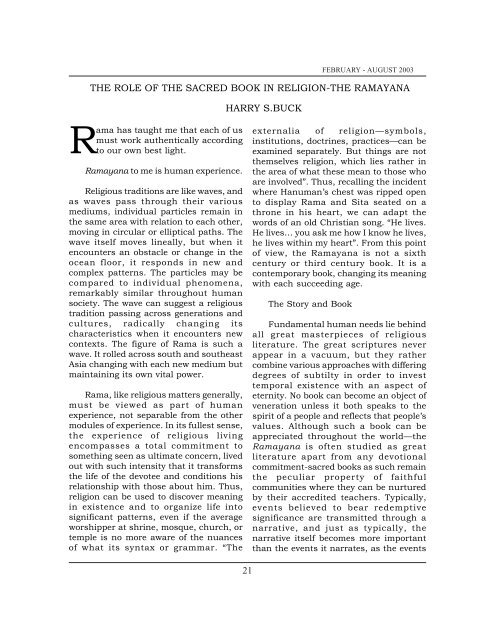Epics in Imprints-1.pdf - Vivekananda Kendra Prakashan
Epics in Imprints-1.pdf - Vivekananda Kendra Prakashan
Epics in Imprints-1.pdf - Vivekananda Kendra Prakashan
Create successful ePaper yourself
Turn your PDF publications into a flip-book with our unique Google optimized e-Paper software.
Rama has taught me that each of us<br />
must work authentically accord<strong>in</strong>g<br />
to our own best light.<br />
Ramayana to me is human experience.<br />
Religious traditions are like waves, and<br />
as waves pass through their various<br />
mediums, <strong>in</strong>dividual particles rema<strong>in</strong> <strong>in</strong><br />
the same area with relation to each other,<br />
mov<strong>in</strong>g <strong>in</strong> circular or elliptical paths. The<br />
wave itself moves l<strong>in</strong>eally, but when it<br />
encounters an obstacle or change <strong>in</strong> the<br />
ocean floor, it responds <strong>in</strong> new and<br />
complex patterns. The particles may be<br />
compared to <strong>in</strong>dividual phenomena,<br />
remarkably similar throughout human<br />
society. The wave can suggest a religious<br />
tradition pass<strong>in</strong>g across generations and<br />
cultures, radically chang<strong>in</strong>g its<br />
characteristics when it encounters new<br />
contexts. The figure of Rama is such a<br />
wave. It rolled across south and southeast<br />
Asia chang<strong>in</strong>g with each new medium but<br />
ma<strong>in</strong>ta<strong>in</strong><strong>in</strong>g its own vital power.<br />
Rama, like religious matters generally,<br />
must be viewed as part of human<br />
experience, not separable from the other<br />
modules of experience. In its fullest sense,<br />
the experience of religious liv<strong>in</strong>g<br />
encompasses a total commitment to<br />
someth<strong>in</strong>g seen as ultimate concern, lived<br />
out with such <strong>in</strong>tensity that it transforms<br />
the life of the devotee and conditions his<br />
relationship with those about him. Thus,<br />
religion can be used to discover mean<strong>in</strong>g<br />
<strong>in</strong> existence and to organize life <strong>in</strong>to<br />
significant patterns, even if the average<br />
worshipper at shr<strong>in</strong>e, mosque, church, or<br />
temple is no more aware of the nuances<br />
of what its syntax or grammar. “The<br />
21<br />
FEBRUARY - AUGUST 2003<br />
THE ROLE OF THE SACRED BOOK IN RELIGION-THE RAMAYANA<br />
HARRY S.BUCK<br />
externalia of religion—symbols,<br />
<strong>in</strong>stitutions, doctr<strong>in</strong>es, practices—can be<br />
exam<strong>in</strong>ed separately. But th<strong>in</strong>gs are not<br />
themselves religion, which lies rather <strong>in</strong><br />
the area of what these mean to those who<br />
are <strong>in</strong>volved”. Thus, recall<strong>in</strong>g the <strong>in</strong>cident<br />
where Hanuman’s chest was ripped open<br />
to display Rama and Sita seated on a<br />
throne <strong>in</strong> his heart, we can adapt the<br />
words of an old Christian song. “He lives.<br />
He lives… you ask me how I know he lives,<br />
he lives with<strong>in</strong> my heart”. From this po<strong>in</strong>t<br />
of view, the Ramayana is not a sixth<br />
century or third century book. It is a<br />
contemporary book, chang<strong>in</strong>g its mean<strong>in</strong>g<br />
with each succeed<strong>in</strong>g age.<br />
The Story and Book<br />
Fundamental human needs lie beh<strong>in</strong>d<br />
all great masterpieces of religious<br />
literature. The great scriptures never<br />
appear <strong>in</strong> a vacuum, but they rather<br />
comb<strong>in</strong>e various approaches with differ<strong>in</strong>g<br />
degrees of subtilty <strong>in</strong> order to <strong>in</strong>vest<br />
temporal existence with an aspect of<br />
eternity. No book can become an object of<br />
veneration unless it both speaks to the<br />
spirit of a people and reflects that people’s<br />
values. Although such a book can be<br />
appreciated throughout the world—the<br />
Ramayana is often studied as great<br />
literature apart from any devotional<br />
commitment-sacred books as such rema<strong>in</strong><br />
the peculiar property of faithful<br />
communities where they can be nurtured<br />
by their accredited teachers. Typically,<br />
events believed to bear redemptive<br />
significance are transmitted through a<br />
narrative, and just as typically, the<br />
narrative itself becomes more important<br />
than the events it narrates, as the events

















